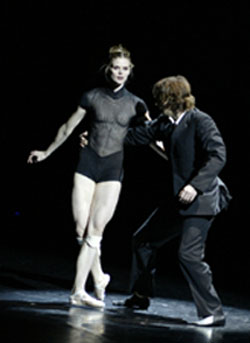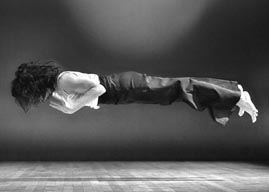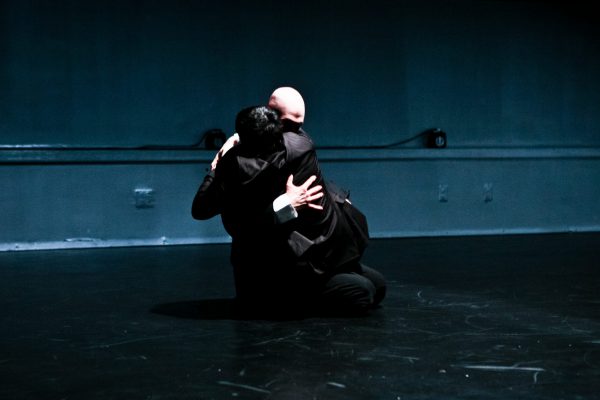Editor’s note: The following is one of a three-part, special feature on interdisciplinarity in dance in Canada. The accompanying pieces include “(Re) Active Bodies” by Kallee Lins, which examines how institutions and funding organizations are conceptualizing interdisciplinarity, and “Beyond Bodies” by Emma Doran, in which she speaks with artists who define their work as lying outside of the traditional boundaries of genre and medium. Read the full feature in July/August 2016.
“I love the potential of cross-disciplinary work,” Toronto-based dance artist and curator Jenn Goodwin tells me as we chat over Skype. Goodwin was charged with the dance programming this year for SummerWorks, Canada’s largest curated performing arts festival. Unlike past years, this year’s SummerWorks program will not divide shows by discipline into categories such as dance, live art, music and theatre. “Part of the reason we’re doing this,” she explains, “is in the hope that people who would normally not go see dance or theatre are just going to look at the programming as art. Because there are people who only go see theatre or only go see dance. Losing the definitions is kind of exciting because it blows open the [spectators’] options.”
As a choreographer whose work leans toward the “interdisciplinary” side of art – and who is presenting at SummerWorks this year – I find this change exciting. I’ve used text and live music in my shows for years and sometimes hesitate to define my art as dance, not only for fear that labelling it so might influence the way spectators view or receive my shows but also because I am not always sure if the label accurately represents my creative process or the hybrid forms of my work. These interests and concerns are shared by many artists, but if they, as I do, embrace the idea of creating scenic performances that cannot neatly be categorized and draw tools from other disciplines to create our work, could dance be in danger of disappearing from our artistic landscape? Or, as modes of artistic creation become increasingly overlapping, and disciplinary boundaries seem to fade away, is there indeed anything that remains singular to dance, or that distinguishes it from other art forms? And if so, is there any reason for us as a community to try to maintain some sort of notion of what dance is or is not?
Daniel Soulières, director of Danse-Cité, an organization that has presented innovative choreographic work in Montréal for close to thirty-five years, told me that he thinks dance will always remain a distinct art form, even if our understanding of the discipline shifts over time. “Dance is the art of movement,” he explains, “or non-movement, of a body that moves through space and is incarnated. With dance, you don’t have the choice but to speak with the body.” Similarly, Goodwin says that although the boundaries of artistic disciplines have become blurred, she believes that “There’s an urgency in dance to speak with the body, to go beyond what we’re able to do through other means of communication.” Toronto choreographer Ame Henderson agrees. “Dance is about labour,” she says. “It’s about the body; it’s about time spent, sensation [and] liveness.”
It is perhaps, then, the presence of the body – and a desire to express one’s self through and from the body – that continues to define dance as an art form. But of course, when working with the body as one’s artistic medium, one is faced with different challenges and needs than an artist who works with words or materials such as paint and canvas. “The potential for injury is high [in dance],” Goodwin notes. “We even have to think about the type of floor we’re working on. A swept, let alone sprung, floor is something that is important to dance but easily overlooked. And it’s not that people [in other disciplines] don’t know that, but I know that I’ve had to ask, [when performing in a visual arts space] ‘Can I have a glass of water?’ Bodies and objects take different care and need different conditions.” She laughs, “A sculpture’s not asking for water!”
Yet Henderson adds that far from being an individual venture, dance is also about “collectivity and being with other people.” Similarly, Soulières stresses that dance can create opportunities to reflect on the embodied nature of living and being together in the world. “[As dancers], we start from what the choreographer wants,” he notes, “but what we give back to him or her, and then share with the audience, is our own information, our own self … it goes further than reproducing movement.” For Marie Mougeolle, a Montréal-based dancer who recently finished an MA at UQÀM on interdisciplinary practices in dance, this constant exchange between the self and other is one of the elements that defines dance as an art form. “Dance offers a space,” she reflects, “through the dancers’ actions, that puts us into contact with alterity. It is an art form that is directed out towards ‘otherness,’ either by engaging with the spectator, or with the ‘other’ inside of you, or that of your [dance] partner. Even if you’re dancing by yourself in the dark, as a dancer you’re always digging further and discovering something new inside of yourself.”
What’s more, the “liveness” and collaborative nature of dance and its embodied nature mean that it is an art form that takes an incredible amount of time and physical labour to create. “Choreographing requires dancers to be present at rehearsals,” says Soulières. “A choreographer works with the body. So, the body needs to be present! And of course ideally, you would have a team of strong artistic collaborators. Dance therefore also requires a lot of meetings, dialogue and discussions. And all that can become expensive. It’s very different, say, than writing a script, or a musical partition, which you could do by yourself at home. Of course there might be some scriptwriters or composers who create in studio with their performers. But in dance we don’t have the choice; we need the bodies to be present. It’s an art form that takes more time and money to develop.” Dominic Simoneau, coordinator in charge of professional development at the Regroupment québecois de la danse (RQD), echoes this statement. “Creating dance takes time,” he explains. “It takes research, rehearsals, preparation, not only to work on the movement but also on all the other [artistic] elements that need to be integrated into the work. If there’s a theatrical approach, or a circus approach, or a musical approach … if artists are working in an inter- or multidisciplinary way, they need time to work on all the different elements [of the choreography]. And they might not have that time because of financial constraints.”
Simoneau stresses, however, that while the RQD is concerned with advocating for proper working conditions for dance artists, the organization is not interested in limiting or controlling artistic expression in any way, or in defining what dance is or is not from an aesthetic standpoint. “A dance that doesn’t dance, a non-dance, is still a reflection on movement, a way of writing the body,” he says. “We don’t make aesthetic judgments and distinctions at the RQD. We represent artists who are reflecting on the body. We need to stay open so that dancers and creators feel free to explore. Our job is to make sure we are responding to the needs of their creations, helping to provide the tools they need. Our interest is in defining professionalism. We are thinking in terms of improving work conditions [for dance professionals]. That’s why we have membership criteria. Our aim isn’t to refuse people [based on aesthetic judgments]; it’s to evaluate how a person responds to the [professional] criteria we have in place.”
But despite the centrality of the body, space and time in dance, Mougeolle questions whether there is indeed any need to maintain any disciplinary divisions when talking about contemporary art. “Who is it that talks about disciplines?” she asks. “It’s not the artists but the funders and the presenters, the art critics. All these people who need to develop a discourse around the artists’ practices. And it’s a way to give spectators some hints on how to look at the work. So, in a way, it’s a commercial consideration really.” Mougeolle suggests that in terms of situating contemporary creation, “There’s no need to divide things and say, ‘This is dance, this is visual art.’ You end up trying to quantify something that is really quite arbitrary. Interdisciplinarity is a way of doing,” she concludes. “It’s not a new aesthetic to fit into, with its own recipes and traps. It’s just a way of doing. It’s a process, not a result.”
Mougeolle reflects, however, that there could be some value to maintaining some sort of disciplinary definition around dance, not in order to limit experimentation or artistic expression but rather, “to know, as an artist, how to situate yourself in relation to your peers, to those who came before you and to those who will come after. That can be incredibly enriching.” Henderson agrees, adding that innovation occurs in relation to what has come before. “How can I even know that I’m working on choreography and how it could change,” she asks, “if I don’t even know what choreography is now or where it’s come from?” Henderson explains that maintaining a connection to the notion of dance as a discipline has provided her a fertile ground for artistic exploration over the years. “I kind of reject the idea of interdisciplinarity,” she laughs, “and am more interested in how I can appropriate tools or materials from other fields to work on choreography. So that my choreography might look like a book in the end, but it’s still a choreography. Maybe it’s just apples and oranges. Maybe it doesn’t matter so much to insist that what I do is choreography. But I’ve found the insisting to be really productive. It’s almost like, where do you want to start your argument from?” she asks. “I’m just most comfortable to start my artistic argument from the place that I’ve been articulating for the longest time, and the one I find the most important.”





